Cost-effectiveness of trachoma control measures: comparing targeted household treatment and mass treatment of children
Kevin D. Frick,1 Thomas M. Lietman,2 Susan Osaki Holm,3 Hem C. Jha,4 J.S.P. Chaudhary,5 & Ramesh C. Bhatta6
OBJECTIVE: The present study compares the cost-effectiveness of targeted household treatment and mass treatment of children in the most westerly part of Nepal.
METHODS: Effectiveness was measured as the percentage point change in the prevalence of trachoma. Resource measures included personnel time required for treatment, transportation, the time that study subjects had to wait to receive treatment, and the quantity of azithromycin used. The costs of the programme were calculated from the perspectives of the public health programme sponsor, the study subjects, and the society as a whole.
FINDINGS: Previous studies have indicated no statistically significant differences in effectiveness, and the present work showed no significant differences in total personnel and transportation costs per child aged 110 years, the total time that adults spent waiting, or the quantity of azithromycin per child. However, the mass treatment of children was slightly more effective and used less of each resource per child aged 110 years than the targeted treatment of households.
CONCLUSION: From all perspectives, the mass treatment of children is at least as effective and no more expensive than targeted household treatment, notwithstanding the absence of statistically significant differences. Less expensive targeting methods are required in order to make targeted household treatment more cost-effective.
Keywords: Trachoma/drug therapy; Azithromycin/supply and distribution; Child; Cost-benefit analysis; Comparative study; Nepal (source: MeSH).
Mots clés: Trachome/chimiothérapie; Azithromycine/ressources et distribution; Enfant; Analyse cot-bénéfice; Etude comparative; Népal (source: INSERM).
Palabras clave: Palabras clave: Tracoma/quimioterapia; Azitromicina/provisión y distribución; Niño; Análisis de costo-beneficio; Estudio comparativo; Nepal (fuente: BIREME).
Introduction
Trachoma remains endemic primarily in the poorest regions of some of the poorest countries of the world and has been described as a forgotten disease of forgotten people (1). WHOs SAFE strategy (Surgery for trichiasis, Antibiotic treatment of trachoma, and Face-washing and Environmental change to reduce the spread of disease) can be used in attempts to accelerate the decrease in the prevalence of trachomatous blindness (2). Trachomatous blindness in adulthood is the consequence of a process that begins in childhood. Individuals who have repeated episodes of ocular infection by Chlamydia trachomatis are at risk for sequelae. The severity of infection is classified as intense or follicular. Individuals with intense infection are at higher risk of sequelae than those with only follicular infection. Sequelae include scarring of the upper eyelid and inturned eyelashes, possibly leading to corneal opacification and blindness (3).
A single-dose treatment with azithromycin can be employed as the antibiotic component of the SAFE strategy. Azithromycin can be used to treat either an entire population subgroup (e.g. all children aged 110 years) or targeted subgroups (e.g. all households with a child aged 110 years with active trachoma). The relative effectiveness and cost of these approaches for both the public health programme sponsor and the targeted population are important considerations in allocating resources to a trachoma control programme.
In the present study, interventions were carried out in the most westerly part of Nepal in wards where active trachoma occurred in over 15% of children. In a national study it was found that trachoma accounted for approximately 4% of all blindness (4), and it had previously been reported that the disease occurred predominantly in the most westerly part of the country (5). Although no significant difference in effectiveness was detected between the mass treatment of children and targeted household treatment (6), a cost comparison was nevertheless desirable in order to assess which treatment was less costly. The present study involved a cost-effectiveness analysis in which two methods of distributing azithromycin were compared: the mass treatment of children aged 110 years and the targeted treatment of children aged 110 years with clinically active trachoma together with the other members of their households. Targeted treatments are intuitively appealing because of the expectation that the resources used, including antibiotics, will be directed to the persons most in need and to those around them to whom they could transmit the disease. The potential cost-effectiveness of targeted household treatment for trachoma control may be difficult to achieve, however, because of the problems posed by diagnosing trachomatous infection on the basis of only a clinical examination(7, 8).
Methods
The economic theory underlying cost-effectiveness research in developing countries and useful methodological approaches have been described previously (912).
Study design
The methods for providing targeted and mass treatments have been described elsewhere (6). In Nepal a ward is a subdivision of the smallest unit of local government, the village development committee (VDC). Each VDC covers a geographically defined region and contains 9 wards. Wards were identified in which the average prevalence of active trachoma in children exceeded 15%. The study was explained to ward chiefs and community members.
Individual wards, or combinations of wards that shared a common school, were randomly allocated to one of the following two treatments.
All children aged 110 years were examined and treated with a dose of azithromycin adjusted for body weight. In the light of previous studies it was not expected that adverse effects of azithromycin would pose a problem for mass treatment (13, 14).
Screening was conducted in order to identify children with active trachoma. They, their siblings and other household members were treated with azithromycin; pregnant women were offered erythromycin or topical treatment. As described previously, household composition data had been gathered when a census was taken before the intervention (6). Households, defined as all individuals dwelling in the same free-standing structure, included 1.5 families on average.
Measuring effectiveness of interventions
The prevalence of trachoma in the wards was measured by a previously described procedure just before and six months after the interventions (6). WHOs simplified grading scheme was used to determine whether individuals had active trachoma (15). Initial screening was performed in December 1998 and follow-up screening took place in June 1999. In accordance with ordinary seasonal fluctuations, the prevalence of active trachoma would be expected to be higher in June than in December.
Effectiveness was measured by the percentage point change in the prevalence of trachoma in children aged 110 years between the baseline and the six-month assessments. The percentage point change was used in the cost-effectiveness analysis because one preferred measure of effectiveness (disability-adjusted life years averted) is based on the number of cases avoided rather than on the proportion of cases avoided. The percentage point change was also acceptable because the average baseline prevalence was similar in the two treatments.
Unit of measurement of costs
The unit of measurement for costs was the cost per child aged 110 years in a ward, i.e. the cost per member of the target population. Consequently, differences in average cost between villages were based on differences in efficiency rather than differences in village size. The number treated or screened was noted in each ward. A sample of five wards spanning the two study arms indicated that, on average, 79% of the children in the wards presented for screening or treatment.
Perspectives on costs
Costs were measured from the perspectives of the public health programme sponsor, the ward members, and society, i.e. combining the previous two. The programme sponsor was either the government or a nongovernmental organization. The programme sponsors costs were tabulated with and without the cost of azithromycin.
Excluded costs
The costs of research were not included as part of the intervention costs. In particular, the costs incurred by both the public health programme sponsor and the ward members in relation to all testing other than the survey for clinical activity and screening at the six-month follow-up were excluded. Any intervention would use WHOs simplified grading scheme rather than other testing.
Quantity and price measures for included costs
The persons carrying out the study completed forms that yielded data on the length of time required for the intervention in each ward. The forms indicated the personnel who went to the wards, the times of entry into and departure from the wards, and the proportions of time spent in research and intervention activities. The intervention time in each ward was calculated from these data.
Monthly wage rates were provided by the Geta Eye Hospital in Nepal. Wages for the investigators from the USA were adjusted to levels appropriate for equivalent personnel from Nepal who were not trained to do the research. In order to calculate an hourly wage rate the monthly rate was divided by 26 x 7 (working days per month x hours per working day). An hourly rate was used because not all wards required an entire day for treatment, and, in some cases, several wards were treated simultaneously.
Each individuals wage earned for the time spent in a ward was the product of the hourly rate, the number of hours and the proportion of the time spent on intervention activities. The wages for all personnel who went to a ward were summed.
The members of the treatment team also spent time travelling to the wards. Travel time was standardized to the average across all villages so that the variation in cost was attributable to the number of trips rather than the distances to the villages. Transportation costs also included the cost of using a vehicle. The project paid a daily charge of 1000 Nepali rupees (NPR) to the Geta Eye Hospital for the use of their vehicle.When more than one ward was visited on a given day the total cost of using a vehicle was apportioned in accordance with the time spent in each.
The only part of ward members time that was counted as a cost was that spent waiting for examination and treatment. On the basis of the average number of children aged <10 years in a family, one adult was assumed to accompany 1.86 children for screening and treatment in the wards where the mass treatment of children was conducted. The childrens time was not valued, as there was no standard method for calculating the opportunity cost of childrens time. In the wards where targeted household treatment took place, one adult was assumed to wait with each 1.86 children for screening and adult time spent waiting for household treatment was also counted. Average census data indicated that 1.24 adults, i.e. persons aged over 14 years, had to wait with each child treated in the targeted household treatment group.
A monetary value was assigned to ward members waiting time so that a societal cost measure could be constructed. The annual average value added per agricultural worker in Nepal approximated to the suggested measure (16), i.e. the annual earnings of a rural adult (9). This was converted into an hourly rate, multiplied by the number of hours spent waiting, and the value obtained was converted from US$ into NPR using the average exchange rate during 1995. Finally, conversion into the value of the NPR in 1998 was effected on the basis of the consumer inflation rate in Nepal (1720).
The quantities of azithromycin used were obtained from project records. Boxes of six 250-mg capsules were obtained for 238 NPR (1999) each from an Indian supplier (Wockhardt Ltd., Mumbai, India). This was lower than the published wholesale cost in the USA (21). At the time of the study there was no supplier of azithromycin suspension in Nepal. For the present analysis the listed relative average wholesale prices of a capsule (US$ 6.22; Allscripts, Libertyville, IL, USA) and a 30-ml bottle of suspension (US$ 27.74; Pfizer, New York, NY, USA)(21) were assumed to be uniform internationally.
Statistics
All statistical tests were performed by means of Stata 6.0 (StataCorp. 1999, Stata Statistical Software, Release 6.0, College Station, TX, USA). Each ward yielded one observation on the average cost per child aged 110 years. The total costs were divided by the number of children screened and adjusted on the assumption that 79% of the children presented for screening or treatment. A weighted average per child was calculated from the data on the cost per child, using the number of children screened as the weight. Simple weighted linear regressions were used to test for differences in cost between treatments.
Results
Table 1 shows the source of data for each element of the cost calculation. The data were obtained directly, taken from published reports, or based on assumptions.
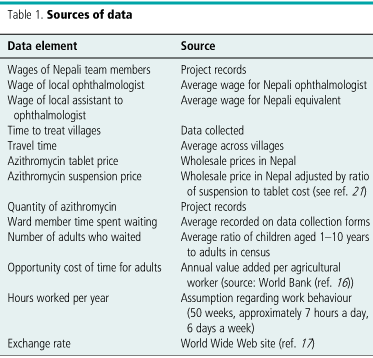
Table 2 shows the results on efficacy. The mass treatment was marginally more effective than the targeted household treatment. The lack of a statistically significant difference has been demonstrated elsewhere (6). In the wards where the mass treatment of children was conducted, the weighted average change in prevalence was 6.4 percentage points, whereas a corresponding value of 4.4 percentage points was obtained for the targeted household treatment.
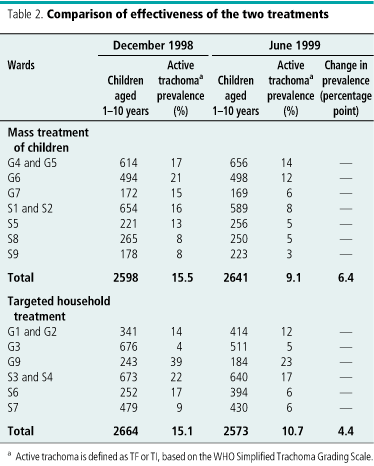
Table 3 compares the personnel and travel costs associated with the two arms of the study. Each ward where the mass treatment of children took place required one round trip taking 36 min each way on average for all the wards. Each ward where targeted household treatment took place required at least two round trips that were assumed to take the same time. Since fieldwork not associated with a study was unlikely to involve the treatment team returning to the ward more than twice, it was assumed that screening and treatment in these villages required exactly two round trips. This biased the total cost of targeted household treatment downward for a given level of effectiveness. Mass treatment of children was given in one more ward of the study than was the case with targeted household treatment, and this biased the cost upward for mass treatment. However, the personnel and transportation costs were lower individually and also in combination for the mass treatment of children, although no statistically significant differences were found. The primary reason for the difference in personnel cost per child examined was the need for return visits to targeted households in which there were children with active trachoma so that treatment could be given to all members of these households. Two-tailed tests in weighted simple linear regressions indicated that there were no statistically significant differences between the treatments in respect of cost components or totals (P < 0.05).
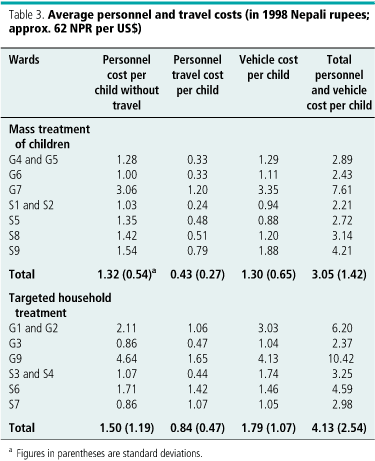
Table 4 shows data on average antibiotic utilization within the treatments. The targeted household treatment required an additional 1.3 capsules per child and saved approximately 0.1 bottles of suspension per child screened. The cost of azithromycin per child was over twice as high in the wards where targeted household treatment was carried out than in those where mass treatment was conducted, although the difference was not statistically significant according to a two-tailed test in a weighted simple linear regression. Such tests also indicated that the total amounts of azithromycin used were not significantly different (P < 0.05). The cost of the suspension was significantly greater for mass treatment of children than for targeted household treatment, whereas the cost of capsules was significantly greater in the latter treatment.
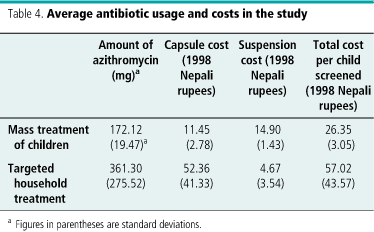
Table 5 compares adult ward members opportunity costs of time in the two treatments. Valuing Nepali agricultural workers time at approximately 5.7 NPR per hour, the difference in the total waiting time cost per child was approximately 0.3 NPR. The total average waiting time was divided between the average waiting time for examination and that for treatment. On average, the targeted household treatment wards had lower opportunity costs for initial waiting times than the mass treatment wards. However, the average opportunity cost of the total waiting time was higher in the targeted wards because of the longer time required for treatment of a family than for that of a child. Use of two-tailed tests in weighted simple linear regressions indicated that neither the opportunity cost of the time spent waiting for the initial examination nor that of the total waiting time was significantly different between treatments (P < 0.05).
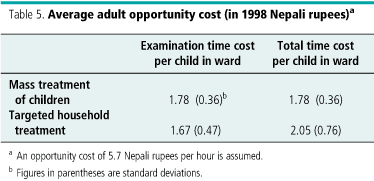
Since the average time to treat a family was 26.4 minutes, the total treatment time in the villages where targeted household treatment was performed would still have been longer unless the prevalence of active trachoma fell below 4.5%, a level that occurred in only one ward at baseline.
Two of the wards (or combinations of wards) in the targeted household treatment had an inordinately high waiting time for the initial examination and for the treatment, whereas this occurred in only one ward combination where the mass treatment was given. Two of the three wards that had inordinately high times were among the largest, although in one large ward the intervention appeared to operate efficiently and in another the waiting time was high but not inordinately so. Outlier waiting times in the large wards, therefore, probably did not have an inordinate influence on the results.
Asummary of costs is given in Table 6. As noted above, there were no statistically significantly differences in individual cost components. The difference in the costs from the adult ward members perspective is not statistically significant. The difference in the public health programme sponsors costs, excluding azithromycin, is small. From the societal perspective the difference in the cost of azithromycin is dominant.
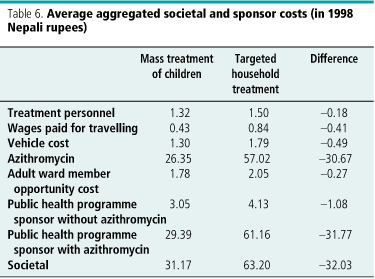
Discussion
The targeted household treatment was no more effective, was more costly in personnel time, and used more antibiotic than the mass treatment. Less waiting time was required in the targeted treatment of adult ward members whose children did not have trachoma but the average total time required was nearly identical in the two treatments.
Sensitivity analyses could be performed in order to assess the robustness of the finding that the mass treatment of children was less expensive than the targeted household treatment under different assumptions. Such analyses were not undertaken, however, because the following changes in assumptions would make the targeted household treatment even more costly relative to the mass treatment of children.
First, all return visits to the wards where targeted household treatment took place could have been included in the cost calculation, rather than assuming that only two visits were made. This change in assumptions would have increased the personnel costs for the targeted household treatment, so that the total costs would have been even higher relative to those for the mass treatment of children. Second, per diem wages could have been used instead of hourly wages. However, the per diem wages were higher and would have increased the cost differential between the two treatments. Third, it could have been assumed that the number of randomized units was the same in both treatments, eliminating one round trip in respect of the mass treatment of children. This would have decreased the costs only in the wards where mass treatment was effected, again making the difference appear larger. These three changes in assumptions would all have made mass treatment relatively less expensive.
Differences in personnel costs should be interpreted cautiously. One of the wards in the targeted household treatment was the first to be visited in the study. On that occasion the hospital provided extra support, leading to inordinately high wages. Another village where targeted household treatment took place required a third examination site and the ward members were particularly difficult to keep in order. In the absence of similar effects in the mass treatment wards the targeted household treatment wards were at a disadvantage. Variation in costs among the wards in the targeted household treatment was more substantial. However, even if all the costs per child in the inordinately expensive ward were decreased to the lowest observed levels in this treatment, the societal cost per child would still be higher for the targeted household treatment. A major reason for the difference in personnel costs is the need for trained personnel to conduct clinical examinations in the targeted household approach.
It is important to consider the magnitude of the differences in cost with respect to groups of wards rather than per child. Among a total of approximately 3300 children, each treatment included approximately 2600 who were treated or screened. To apply either treatment to the entire area under study would therefore imply treating about 5200 of 6600 children. At this rate the ward members opportunity costs would be approximately 1800 NPR (US$ 30) higher for the targeted household treatment, or less than 0.5 NPR per adult ward member. The public health programme sponsors extra costs for the targeted household treatment in an area this size would be approximately 56 NPR (US$ 1.10) per adult ward member. Adult ward members were the relevant denominator in this case for two reasons: ward members opportunity costs were based only on adult time and one method of financing a public health programme is to place a tax on adult productivity. The societal cost of mass treatment per one percentage point decrease in prevalence among 5200 children screened was 32 400 NPR (ca US$ 600).
The only large cost difference on a per child basis was the cost of azithromycin. This, in combination with the lack of adverse effects of azithromycin and the potential for drug resistance, suggests that mass treatment of children should remain the treatment of choice until other methods of distributing targeted treatment are devised and tested. Efforts to use health care resources most efficiently should focus on treating the group that is the reservoir for infection in order to decrease the prevalence of trachoma itself.
A cost-effectiveness analysis such as the one reported here can be an important tool in decision-making by health ministries facing tight budgetary constraints. The present analysis highlights the lack of a gain for the extra money that might be spent on a targeted trachoma control programme. The cost differences at the adult ward member level and the sponsor level in the absence of payment for azithromycin are quite small but the inclusion of the cost of azithromycin makes them substantial.
The ultimate goal of treating trachoma, i.e. to avoid blindness, should be kept in mind. Future research is needed to firmly establish the magnitude of the effect of decreasing the prevalence of active disease now on the prevalence of blindness later. Blindness may decrease both in the short run, i.e. if the development of trichiasis depends on persons with scarring being subjected to continued infection (22), and in the long run. By modelling the complete effect of changes in the prevalence of trachoma, more information can be obtained on the overall cost-effectiveness of efforts to control the disease. 
Acknowledgements
The project described in this paper received generous support from the Edna McConnell Clark Foundation and Helen Keller International. Part of K.F.s work on the project was funded by the International Trachoma Initiative. The research was conducted in full accordance with ethical principles, including the provisions of the World Medical Association Declaration of Helsinki (as revised at the 48th General Assembly, Somerset West, Republic of South Africa, October 1996) and those of the Nepal Netra Jyoti Sangh, the Committee on Human Research at the University of California, San Francisco, CA, USA and the Committee on Human Research at the Johns Hopkins University, School of Hygiene and Public Health, Baltimore, MD, USA.
Résumé
Coût-efficacité des mesures de lutte contre le trachome : comparaison entre le traitement sélectif des ménages et le traitement de masse des enfants
OBJECTIF: La présente étude compare le rapport coût-efficacité du traitement sélectif des ménages et du traitement de masse des enfants dans la partie la plus occidentale du Népal.
MÉTHODES: Lefficacité a été mesurée par le changement de prévalence du trachome, exprimé en pourcentage. Les mesures concernant les ressources comprenaient le temps consacré par le personnel au traitement, les transports, le temps passé par les sujets participant à létude à attendre le traitement, et la quantité dazithromycine utilisée. Les coûts relatifs au programme ont été calculés du point de vue de lorganisme parrainant le programme de santé publique, des sujets participant à létude, et de la société dans son ensemble.
RÉSULTATS: Des études antérieures navaient montré aucune différence statistiquement significative defficacité, et les travaux rapportés ici nont montré aucune différence significative au niveau du coût total en personnel et en transport par enfant de 1 à 10 ans, du temps total passé par les adultes à attendre, ou de la quantité dazithromycine utilisée par enfant. Cependant, le traitement de masse des enfants était légèrement plus efficace et utilisait moins de ressources par enfant de 1 à 10 ans que le traitement sélectif des ménages.
CONCLUSION: Quel que soit le point de vue adopté, le traitement de masse des enfants est au moins aussi efficace et pas plus coûteux que le traitement sélectif des ménages, bien que les différences ne soient pas statistiquement significatives. Des méthodes de ciblage moins coûteuses sont nécessaires pour améliorer le rapport coût-efficacité du traitement sélectif des ménages.
Resumen
Eficacia con relación al costo de las medidas de lucha contra el tracoma: comparación del tratamiento de hogares determinados y el tratamiento masivo de niños
OBJETIVO: En el presente estudio se compara la eficacia con relación al costo del tratamiento de hogares seleccionados y el tratamiento masivo de niños en la parte más occidental de Nepal.
MÉTODOS: La eficacia se determinó como la variación porcentual de la prevalencia de tracoma. Como medidas de los recursos se emplearon el tiempo personal requerido para el tratamiento, el transporte, el tiempo que los participantes en el estudio tuvieron que esperar para recibir tratamiento, y la cantidad de azitromicina empleada. Los costos del programa se calcularon teniendo en cuenta las perspectivas del patrocinador del programa de salud pública, de los individuos estudiados y del conjunto de la sociedad.
RESULTADOS: Estudios anteriores no han revelado ninguna diferencia estadísticamente significativa en cuanto a la eficacia, y el presente trabajo no muestra diferencias importantes en lo que respecta a los costos de personal y transporte por niño de 1 a 10 años, el tiempo total de espera de los adultos, o la cantidad de azitromicina por niño. Sin embargo, el tratamiento masivo de los niños fue ligeramente más eficaz y requirió, por niño de 1 a 10 años, un menor uso de cada uno de esos recursos que el tratamiento de determinados hogares.
CONCLUSIONES: Desde todos los puntos de vista, el tratamiento masivo de los niños es como mínimo tan eficaz y no más oneroso que el tratamiento focalizado de hogares, pese a la ausencia de diferencias estadísticamente significativas. Hacen falta métodos de focalización más económicos para que el tratamiento selectivo de los hogares resulte más eficaz con relación al costo.
References
1. Muñoz B, West S. Trachoma: the forgotten cause of blindness. Epidemiological Reviews, 1997, 19: 205217.
2. Report of the First Meeting of the WHO Alliance for the Global Elimination of Trachoma. Geneva, World Health Organization, 1997 (unpublished document WHO/PBL/GET/97.1).
3. Vanghan D, Asbury T, Riordan-Eva P, eds. General Ophthalmology, 15th edit. Stamford, CT, Appleton & Lange, 1999.
4. Pokharel GP et al. Prevalence of blindness and cataract surgery in Nepal. British Journal of Ophthalmology, 1998, 82: 600605.
5. Brilliant G. The epidemiology of blindness in Nepal: report of the 1981 Nepal Blindness Survey. Chelsea, MI, Seva Foundation, 1988.
6. Osaki Holm S et al. Comparison of two azithromycin distribution strategies for trachoma. Bulletin of the World Health Organization, 2001, 79: 194200.
7. Ward M et al. Persisting inapparent chlamydial infection in a trachoma endemic community in the Gambia. Scandinavian Journal of Infectious Diseases. 1990, 69 (suppl): 137148.
8. Baral K et al. Reliability of clinical diagnosis in identifying infectious trachoma in a low-prevalence area of Nepal. Bulletin of the World Health Organization, 1999, 77: 461466.
9. Over M, Bertozzi S, Chin J. Guidelines for rapid estimation of the direct and indirect costs of HIV infection in a developing country. Health Policy, 1989, 11: 169186.
10. Jack W. Principles of health economics for developing countries. Washington, DC, World Bank, 1999.
11. Brent RJ, Cost-benefit analysis for developing countries. Cheltenham, England, Edward Elgar Publishers, 1998.
12. Gold MR et al., eds. Cost-effectiveness in health and medicine. New York, Oxford University Press, 1996.
13. Whitty CJ et al. Impact of community-based mass treatment for trachoma with oral azithromycin on general morbidity inGambian children. Pediatric Infectious Diseases Journal, 1999, 18: 955958.
14. Hopkins S. Clinical toleration and safety of azithromycin. American Journal of Medicine, 1991, 91: 40S45S.
15. Thylefors B et al. A simple system for the assessment of trachoma and its complications. Bulletin of the World Health Organization, 1987, 65: 477483.
16. World Bank. World development indicators 2000. New York, Oxford University Press, 2000: 123.
17. Oanda.com: the currency site. (Internet communication, 17 January 2000 at http://www.oanda.com/convert/fxhistory.)
18. World factbook 1997. Washington, DC, Central Intelligence Agency, 1997.
19. World factbook 1998. Washington, DC, Central Intelligence Agency, 1998.
20. World factbook 1999. Washington, DC, Central Intelligence Agency, 2000.
21. 1999 drug topics red book. Montvale, NJ, Medical Economics, 1999.
22. Muñoz B et al. Incidence of trichiasis in a cohort of women with and without scarring. International Journal of Epidemiology, 1999, 28: 11671171.
1 Assistant Professor, Department of Health Policy and Management, School of Hygiene and Public Health, Johns Hopkins University, 624 N. Broadway, Room 606, Baltimore, MD 212051901, USA (email: kfrick@jhsph.edu). Correspondence should be addressed to this author.
2 Assistant Professor, Department of Ophthalmology and Francis I. Proctor Foundation for Research in Ophthalmology, University of California, San Francisco, CA, USA; and Director, WHO Collaborating Centre for the Prevention of Blindness, San Francisco, CA, USA.
3 Research Coordinator, Francis I. Proctor Foundation for Research in Ophthalmology, University of California, San Francisco, CA, USA.
4 Hospital Director and Chief Ophthalmologist, Geta Eye Hospital, Geta, Nepal.
5 Ophthalmic Officer and Hospital Administrator, Geta Eye Hospital, Geta, Nepal.
6 Ophthalmic Officer, Geta Eye Hospital, Geta, Nepal.
Ref. No. 00-0954
